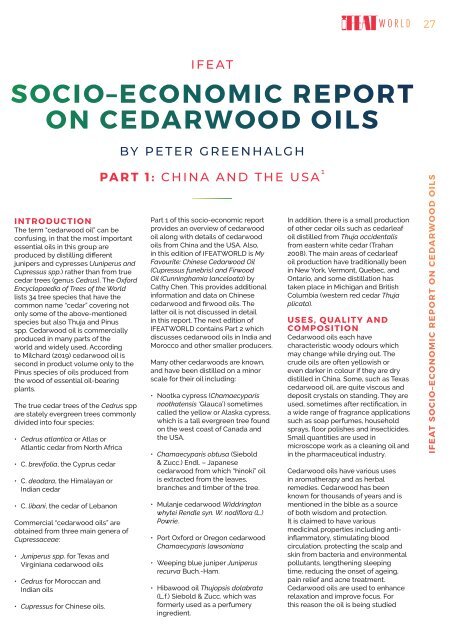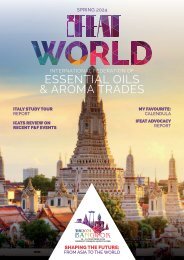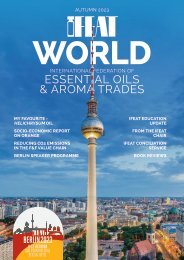IFEATWORLD July 2022
A Members' Newsletter for the International Federation of Essential Oils & Aroma Trades.
A Members' Newsletter for the International Federation of Essential Oils & Aroma Trades.
Create successful ePaper yourself
Turn your PDF publications into a flip-book with our unique Google optimized e-Paper software.
WORLD 27<br />
IFEAT<br />
SOCIO–ECONOMIC REPORT<br />
ON CEDARWOOD OILS<br />
BY PETER GREENHALGH<br />
INTRODUCTION<br />
The term “cedarwood oil” can be<br />
confusing, in that the most important<br />
essential oils in this group are<br />
produced by distilling different<br />
junipers and cypresses (Juniperus and<br />
Cupressus spp.) rather than from true<br />
cedar trees (genus Cedrus). The Oxford<br />
Encyclopaedia of Trees of the World<br />
lists 34 tree species that have the<br />
common name “cedar” covering not<br />
only some of the above-mentioned<br />
species but also Thuja and Pinus<br />
spp. Cedarwood oil is commercially<br />
produced in many parts of the<br />
world and widely used. According<br />
to Milchard (2019) cedarwood oil is<br />
second in product volume only to the<br />
Pinus species of oils produced from<br />
the wood of essential oil-bearing<br />
plants.<br />
The true cedar trees of the Cedrus spp<br />
are stately evergreen trees commonly<br />
divided into four species:<br />
• Cedrus atlantica or Atlas or<br />
Atlantic cedar from North Africa<br />
• C. brevifolia, the Cyprus cedar<br />
• C. deodara, the Himalayan or<br />
Indian cedar<br />
• C. libani, the cedar of Lebanon<br />
Commercial “cedarwood oils” are<br />
obtained from three main genera of<br />
Cupressaceae:<br />
• Juniperus spp. for Texas and<br />
Virginiana cedarwood oils<br />
• Cedrus for Moroccan and<br />
Indian oils<br />
• Cupressus for Chinese oils.<br />
PART 1: CHINA AND THE USA 1<br />
Part 1 of this socio-economic report<br />
provides an overview of cedarwood<br />
oil along with details of cedarwood<br />
oils from China and the USA. Also,<br />
in this edition of <strong>IFEATWORLD</strong> is My<br />
Favourite: Chinese Cedarwood Oil<br />
(Cupressus funebris) and Firwood<br />
Oil (Cunninghamia lanceloata) by<br />
Cathy Chen. This provides additional<br />
information and data on Chinese<br />
cedarwood and firwood oils. The<br />
latter oil is not discussed in detail<br />
in this report. The next edition of<br />
<strong>IFEATWORLD</strong> contains Part 2 which<br />
discusses cedarwood oils in India and<br />
Morocco and other smaller producers.<br />
Many other cedarwoods are known,<br />
and have been distilled on a minor<br />
scale for their oil including:<br />
• Nootka cypress (Chamaecyparis<br />
nootkatensis ‘Glauca’) sometimes<br />
called the yellow or Alaska cypress,<br />
which is a tall evergreen tree found<br />
on the west coast of Canada and<br />
the USA.<br />
• Chamaecyparis obtusa (Siebold<br />
& Zucc.) Endl. – Japanese<br />
cedarwood from which “hinoki” oil<br />
is extracted from the leaves,<br />
branches and timber of the tree.<br />
• Mulanje cedarwood Widdrington<br />
whytei Rendle syn. W. nodiflora (L.)<br />
Powrie.<br />
• Port Oxford or Oregon cedarwood<br />
Chamaecyparis lawsoniana<br />
• Weeping blue juniper Juniperus<br />
recurva Buch.-Ham.<br />
• Hibawood oil Thujopsis dolabrata<br />
(L.f.) Siebold & Zucc. which was<br />
formerly used as a perfumery<br />
ingredient.<br />
In addition, there is a small production<br />
of other cedar oils such as cedarleaf<br />
oil distilled from Thuja occidentalis<br />
from eastern white cedar (Trahan<br />
2008). The main areas of cedarleaf<br />
oil production have traditionally been<br />
in New York, Vermont, Quebec, and<br />
Ontario, and some distillation has<br />
taken place in Michigan and British<br />
Columbia (western red cedar Thuja<br />
plicata).<br />
USES, QUALITY AND<br />
COMPOSITION<br />
Cedarwood oils each have<br />
characteristic woody odours which<br />
may change while drying out. The<br />
crude oils are often yellowish or<br />
even darker in colour if they are dry<br />
distilled in China. Some, such as Texas<br />
cedarwood oil, are quite viscous and<br />
deposit crystals on standing. They are<br />
used, sometimes after rectification, in<br />
a wide range of fragrance applications<br />
such as soap perfumes, household<br />
sprays, floor polishes and insecticides.<br />
Small quantities are used in<br />
microscope work as a cleaning oil and<br />
in the pharmaceutical industry.<br />
Cedarwood oils have various uses<br />
in aromatherapy and as herbal<br />
remedies. Cedarwood has been<br />
known for thousands of years and is<br />
mentioned in the bible as a source<br />
of both wisdom and protection.<br />
It is claimed to have various<br />
medicinal properties including antiinflammatory,<br />
stimulating blood<br />
circulation, protecting the scalp and<br />
skin from bacteria and environmental<br />
pollutants, lengthening sleeping<br />
time, reducing the onset of ageing,<br />
pain relief and acne treatment.<br />
Cedarwood oils are used to enhance<br />
relaxation and improve focus. For<br />
this reason the oil is being studied<br />
IFEAT SOCIO–ECONOMIC REPORT ON CEDARWOOD OILS

















